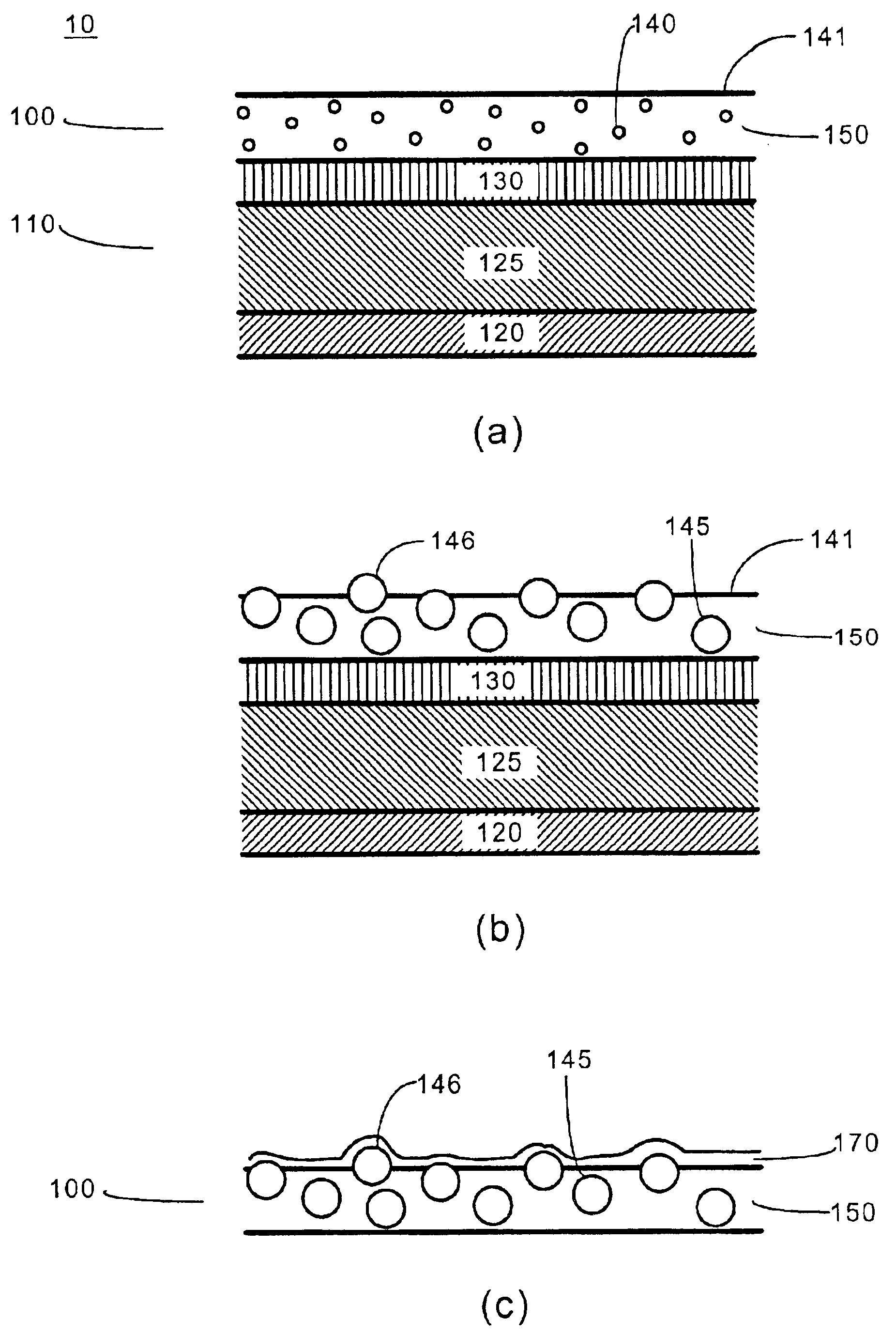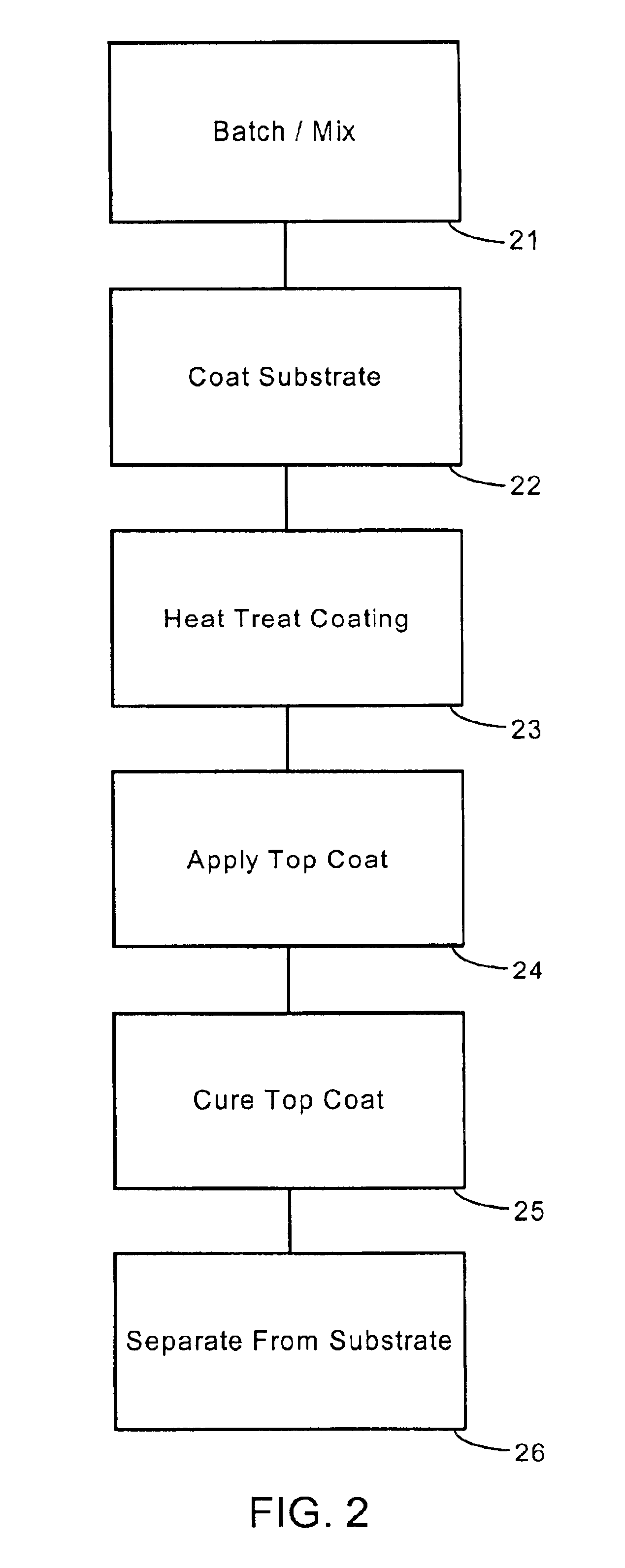Heat activated coating texture
a technology of activated coating and heat, applied in the field of surface texture of covering, can solve the problems of affecting the thickness of the wear layer, swelling of methacrylate particles, and affecting the swelling of plasticizers,
- Summary
- Abstract
- Description
- Claims
- Application Information
AI Technical Summary
Problems solved by technology
Method used
Image
Examples
example 1
The effect of concentration and type of micro-capsules on the texture of thermoplastic coatings are illustrated in this example. Micro-capsules such as Micropearl™ F30D, F50D, F805D1, and F100D1, available from Pierce & Stevens, Buffalo, N.Y., were mixed with PVC plastisols. The PVC plastisol compositions are as described in the '231 patent. Table 1 summarizes chemical and mechanical properties of the micro-capsules used in this example.
TABLE 1Properties of Micropearl ™ Micro-CapsulesExpansionDiameterTemperatureNameShell Composition(μm)(° F.)F30Dpolyvinylidene chloride copolymer10-20248-284F50Dpolyvinylidene chloride copolymer10-20284F80SD1acrylonitrile copolymer16-32320-338F100D1acrylonitrile copolymer16-32356-374
Micro-capsules were added at concentrations ranging from 1 to 10 wt. % to each of the liquid plastisols and mixed in a Cowles blade mixer at room temperature. The mixtures were applied to a gelled PVC substrate using a 10 mil draw bar and produced smooth wet coatings. The ...
example 2
This Example demonstrates the effects of the expansion temperature on the surface texture of thermoplastic coatings. Micro-capsules were mixed with the plastisol and coated onto a gelled PVC substrate following the same procedure as in Example 1. The coated substrates were divided into three groups and each group of coated substrates was gelled a t either 300° F., 345° F., or 385° F. The surface texture of the gelled coatings was evaluated by visual observation, SEM images, and gloss measurements following the same procedure as in Example 1.
Table 3 summarizes the coating textures evaluated by the visual observations and the gloss measurements. In Table 3, the % Gloss Change was calculated relative to the control coatings containing no micro-capsules and having the same gel temperature as the coating. This was done in order to compensate for the effect of gel temperature on surface gloss.
TABLE 3Effect of Gel Temperature and Micro-capsuleConcentration on Coating TextureType ofExpansio...
example 3
This Example demonstrates the effect of depositing a top coat on the textured plastisol coatings. Coatings combining the plastisol with micro-capsules of various types and concentrations were prepared following the same procedure used in Example 1. For each of the coatings prepared, a urethane top coat was applied to a portion of the prepared coatings followed by an evaluation of each of the coating surfaces. The top coat was applied by spreading a UV-curable urethane such as Photoglaze U361, available from Lord Corporation of Cary, N.C., on each of the coatings of Example 1. An air knife was used to produce a wet coating thickness of 1-1.5 mil. The urethane top coat was cured in air under two 125 W / in2 lamps at 100 feet-per-minute (fpm) followed by a second cure under nitrogen under two 300 W / in2 lamps at 100 fpm.
Table 4 summarizes the gloss values of the coatings. Table 4 shows that the top coat slightly reduced the surface texture of all the coated plastisols, as indicated by the...
PUM
| Property | Measurement | Unit |
|---|---|---|
| diameter | aaaaa | aaaaa |
| thick | aaaaa | aaaaa |
| thick | aaaaa | aaaaa |
Abstract
Description
Claims
Application Information
 Login to View More
Login to View More - R&D
- Intellectual Property
- Life Sciences
- Materials
- Tech Scout
- Unparalleled Data Quality
- Higher Quality Content
- 60% Fewer Hallucinations
Browse by: Latest US Patents, China's latest patents, Technical Efficacy Thesaurus, Application Domain, Technology Topic, Popular Technical Reports.
© 2025 PatSnap. All rights reserved.Legal|Privacy policy|Modern Slavery Act Transparency Statement|Sitemap|About US| Contact US: help@patsnap.com



